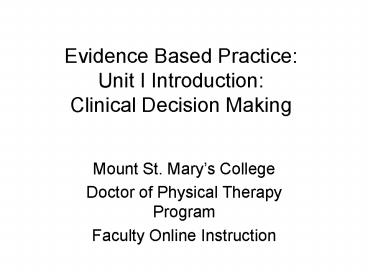Evidence Based Practice: Unit I Introduction: Clinical Decision Making - PowerPoint PPT Presentation
1 / 30
Title:
Evidence Based Practice: Unit I Introduction: Clinical Decision Making
Description:
Evidence Based Practice: Unit I Introduction: Clinical Decision Making Mount St. Mary s College Doctor of Physical Therapy Program Faculty Online Instruction – PowerPoint PPT presentation
Number of Views:217
Avg rating:3.0/5.0
Title: Evidence Based Practice: Unit I Introduction: Clinical Decision Making
1
Evidence Based Practice Unit I
IntroductionClinical Decision Making
Mount St. Marys College Doctor of Physical
Therapy Program Faculty Online Instruction
2
.
- Domain V
- Evaluate Use of evidence
- Assess EBP skills and use of evidence.
- Share and store critical appraisals
- Monitor literature for new evidence
Identify Learning or Developmental Need
.
- Domain I
- Ask Focused Questions
- Identify category of evidence (Diagnosis,
Prognosis, Intervention) - Formulate four-part clinical question
Client/Patient Problem EBP begins and ends here!
Domain IV Apply Findings Interpret evidence in
the context of the specific issues related to
the client/patient problem.
- Domain II
- Search for Evidence
- Use evidence hierarchy to guide search
- Search for meta-analyses, systematic reviews
first. - Search primary literature
- Domain III
- Critically Appraise Evidence
- What is the level of evidence?
- Is the evidence valid?
- Are the results important?
Modified by Slavin, 2005
3
.
- Domain V
- Evaluate Use of evidence
- Assess EBP skills and use of evidence.
- Share and store critical appraisals
- Monitor literature for new evidence
Identify Learning or Developmental Need
.
- Domain I
- Ask Focused Questions
- Identify category of evidence (Diagnosis,
Prognosis, Intervention) - Formulate four-part clinical question
Client/Patient Problem EBP begins and ends here!
Domain IV Apply Findings Interpret evidence in
the context of the specific issues related to
the client/patient problem.
- Domain II
- Search for Evidence
- Use evidence hierarchy to guide search
- Search for meta-analyses, systematic reviews
first. - Search primary literature
- Domain III
- Critically Appraise Evidence
- What is the level of evidence?
- Is the evidence valid?
- Are the results important?
Modified by Slavin, 2005
4
Client/Patient Problem
EBP begins and ends here!
- A patient problem that cannot be answered with
existing knowledge. - A challenge to ones own existing knowledge does
literature support our best judgment??
5
Client/Patient ProblemEBP begins and ends here!
- Recognize
- Reflect
6
Identify Learning or Developmental Need
- Diagnosis
- Prognosis
- Therapy (Intervention)
7
Identify Learning or Developmental Need
- Diagnosis
- Prognosis
- Therapy (Intervention)
8
Identify Learning or Developmental Need
- Diagnosis
- Prognosis
- Therapy (Intervention)
9
Domain IAsk Focused Questions
- Background/Foreground Questions.
- Formulate four-part clinical question
- P atient, population, problem
- I ntervention, prognostic factor, or exposure
- C omparison or alternative intervention
- O utcome to measure or achieve
10
Background Questions
- Pathology
- Novel patient conditions
11
Foreground Questions
- Answerable Question
- P atient, population, problem
- I ntervention, prognostic factor, or exposure
- C omparison or alternative intervention
- O utcome to measure or achieve
- PICOmaker
- http//www.library.ualberta.ca/pdazone/pico/
12
PICOmaker
http//www.library.ualberta.ca/pdazone/pico/
13
Evidence in Practice
- Hoppenrath T, Ciccone CD. Is there evidence that
phonephoresis is more effective than ultrasound
in treating pain associated with lateral
epicondylitis? Phys Ther, 200686136-140.
14
Domain IISearch for Evidence
- Scholarly Literature Databases
- Evidence-Based Medicine Databases
- PubMeds Clinical Queries Cochrane Library are
useful tools.
15
Domain IIICritically Appraise Evidence
- Use evidence hierarchy to guide selection and
appraisal - Meta-analyses, systematic reviews first.
- Randomized Controlled Trials
16
Systematic Reviews and Meta-Analyses
Randomized Controlled Trials
Cohort Studies
Case Control Studies
Opinions, Letters
Animal Research
In vitro Research
17
Systematic Reviews and Meta-Analyses
Randomized Controlled Trials
Cohort Studies
Case Control Studies
Opinions, Letters
Animal Research
In vitro Research
18
Systematic Reviews and Meta-Analyses
Randomized Controlled Trials
Cohort Studies
Case Control Studies
Opinions, Letters
Animal Research
In vitro Research
19
Systematic Reviews and Meta-Analyses
Randomized Controlled Trials
Cohort Studies
Case Control Studies
Opinions, Letters
Animal Research
In vitro Research
20
Systematic Reviews and Meta-Analyses
Randomized Controlled Trials
Cohort Studies
Case Control Studies
Opinions, Letters
Animal Research
In vitro Research
21
Systematic Reviews and Meta-Analyses
Randomized Controlled Trials
Cohort Studies
Case Control Studies
Opinions, Letters
Animal Research
In vitro Research
22
Systematic Reviews and Meta-Analyses
Randomized Controlled Trials
Cohort Studies
Case Control Studies
Opinions, Letters
Animal Research
In vitro Research
23
Systematic Reviews and Meta-Analyses
Randomized Controlled Trials
Cohort Studies
Case Control Studies
Opinions, Letters
Animal Research
In vitro Research
24
Domain IIICritically Appraise Evidence
- Is the evidence valid?
- Are the results important?
25
Evidence rating scales
- Single Article
- PEDro Scale (for RCTs)
- Reviews
26
CAT Development
- Critically Appraised Topics
- http//www.cebm.net/catmaker.asp
27
Domain IVApply Findings
- Interpret evidence in the context
- of the specific issues related to the
- client/patient problem.
28
Domain VEvaluate Use of evidence
- Assess your own EBP skills and use of evidence.
- Share and store critical appraisals (CATs)
- Monitor literature for new evidence
29
Useful Websites
- www.cebm.net/toolbox.asp
- www.cebm.utoronto.ca
- www.ptjournal.org/info/eipList_backup.cfm
- www.otcats.com/topics/index.html
- www.guideline.gov
- www.pedro.fhs.usyd.edu.au/index.html
- www.hookedonevidence.com
- (requires APTA membership)
- www.informedhealthonline.org
30
Summary
- EBP Defined
- Sacketts Model
- Applied to the Guide































